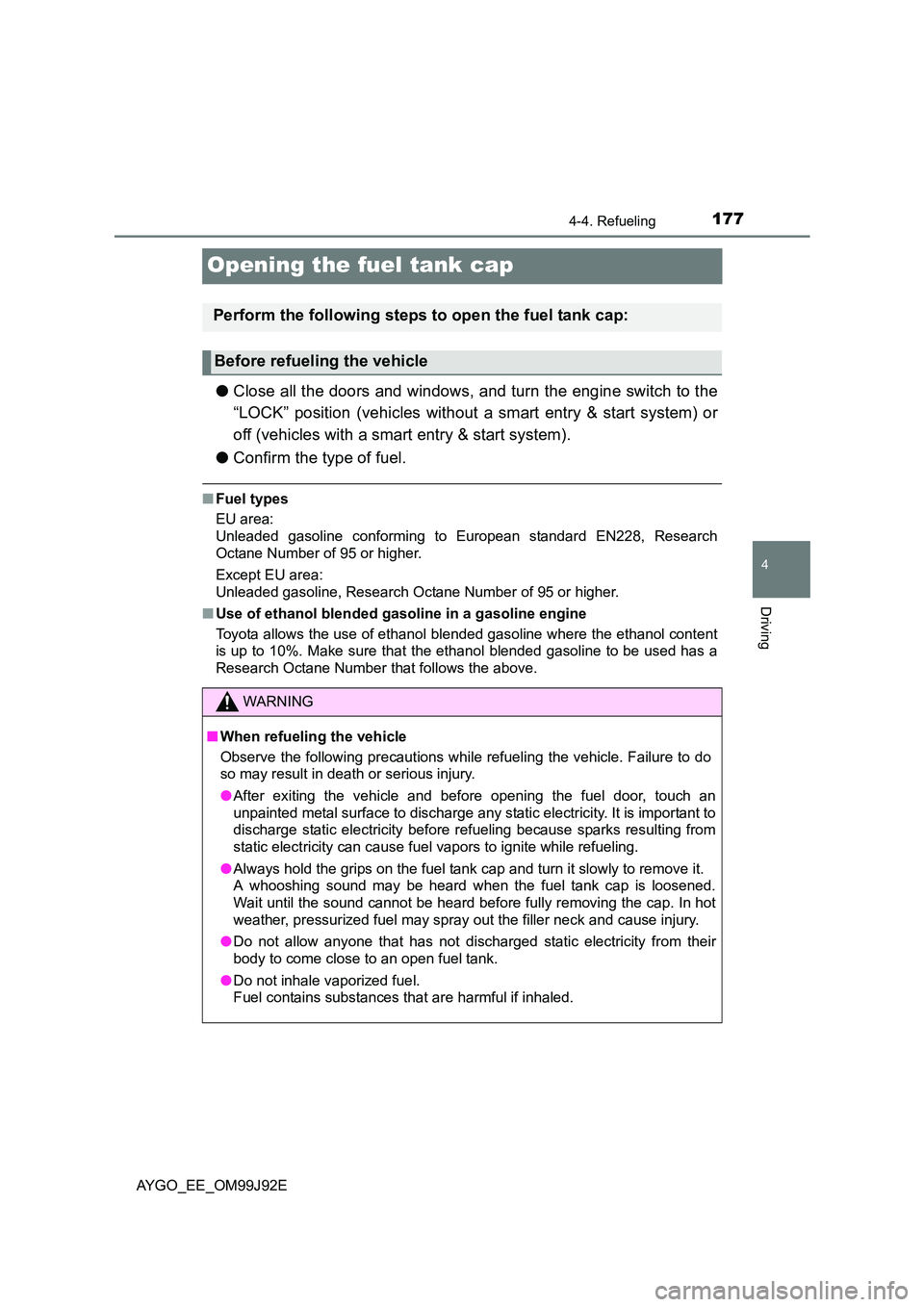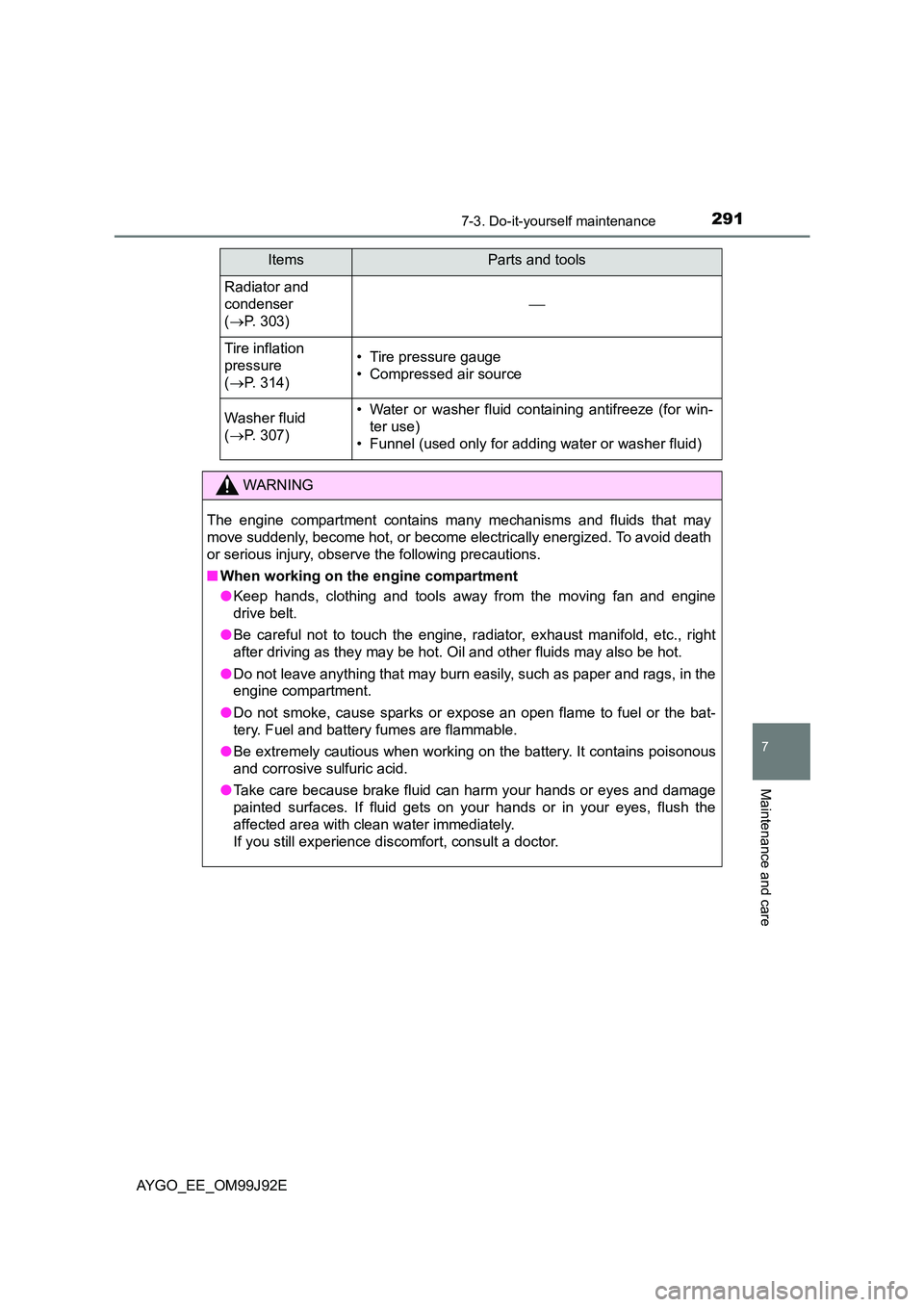Page 163 of 440
163
4
4-2. Driving procedures
Driving
AYGO_EE_OM99J92E
Manual transmission∗
Fully depress the clutch pedal before operating the shift lever, and
then release it slowly.
If it is difficult to shift in reverse, shift the shift lever to N, release the clutch
pedal momentarily, and then try again.
The Gear Shift Indicator is a guide to help the driver achieve improved
fuel economy and reduced exhaust emissions within limits of engine
performance.
Upshifting
Downshifting (1KR engine only)
∗: If equipped
Shifting the shift lever
Gear Shift Indicator
1
2
Page 177 of 440

177
4
4-4. Refueling
Driving
AYGO_EE_OM99J92E
Opening the fuel tank cap
●Close all the doors and windows, and turn the engine switch to the
“LOCK” position (vehicles without a smart entry & start system) or
off (vehicles with a smart entry & start system).
● Confirm the type of fuel.
■Fuel types
EU area:
Unleaded gasoline conforming to European standard EN228, Research
Octane Number of 95 or higher.
Except EU area:
Unleaded gasoline, Research Octane Number of 95 or higher.
■ Use of ethanol blended gasoline in a gasoline engine
Toyota allows the use of ethanol blended gasoline where the ethanol content
is up to 10%. Make sure that the ethanol blended gasoline to be used has a
Research Octane Number that follows the above.
Perform the following steps to open the fuel tank cap:
Before refueling the vehicle
WARNING
■ When refueling the vehicle
Observe the following precautions while refueling the vehicle. Failure to do
so may result in death or serious injury.
● After exiting the vehicle and before opening the fuel door, touch an
unpainted metal surface to discharge any static electricity. It is important to
discharge static electricity before refueling because sparks resulting from
static electricity can cause fuel vapors to ignite while refueling.
● Always hold the grips on the fuel tank cap and turn it slowly to remove it.
A whooshing sound may be heard when the fuel tank cap is loosened.
Wait until the sound cannot be heard before fully removing the cap. In hot
weather, pressurized fuel may spray out the filler neck and cause injury.
● Do not allow anyone that has not discharged static electricity from their
body to come close to an open fuel tank.
● Do not inhale vaporized fuel.
Fuel contains substances that are harmful if inhaled.
Page 178 of 440
1784-4. Refueling
AYGO_EE_OM99J92E
WARNING
● Do not smoke while refueling the vehicle.
Doing so may cause the fuel to ignite and cause a fire.
● Do not return to the vehicle or touch any person or object that is statically
charged.
This may cause static electricity to build up, resulting in a possible ignition
hazard.
■ When refueling
Observe the following precautions to pr event fuel overflowing from the fuel
tank:
● Securely insert the fuel nozzle into the fuel filler neck.
● Stop filling the tank after the fuel nozzle automatically clicks off.
● Do not top off the fuel tank.
NOTICE
■ Refueling
Do not spill fuel during refueling.
Doing so may damage the vehicle, such as causing the emission control
system to operate abnormally or damaging fuel system components or the
vehicle’s painted surface.
Page 179 of 440
1794-4. Refueling
4
Driving
AYGO_EE_OM99J92E
Pull up the opener to open the
fuel filler door.
Turn the fuel tank cap slowly to
open.
Hang the fuel tank cap on the
back of the fuel filler door.
Opening the fuel tank cap
1
2
3
Page 180 of 440
1804-4. Refueling
AYGO_EE_OM99J92E
After refueling, turn the fuel tank
cap until you hear a click. Once
the cap is released, it will turn
slightly in the opposite direction.
Closing the fuel tank cap
WARNING
■ When replacing the fuel tank cap
Do not use anything but a genuine Toyota fuel tank cap designed for your
vehicle. Doing so may cause a fire or other incident which may result in
death or serious injury.
Page 283 of 440

2837-1. Maintenance and care
7
Maintenance and care
AYGO_EE_OM99J92E
■Automatic car washes
● Vehicles with a canvas top: Do not use the automatic car washes.
● Fold the mirrors and remove the antenna before washing the vehicle. Start
washing from the front of the vehicle. Make sure to re-install the antenna
and extend the mirrors before driving.
● Brushes used in automatic car washes may scratch the vehicle surface and
harm your vehicle’s paint.
● Rear spoiler may not be washable in some automatic car washes. There
may also be an increased risk of damage to vehicle.
■ High pressure car washes
● Vehicles with a canvas top: Do not use the high pressure car washes.
● Do not allow the nozzles of the car wash to come within close proximity of
the windows.
● Before using the car wash, check that the fuel filler door on your vehicle is
closed properly.
■ Aluminum wheels (if equipped)
● Remove any dirt immediately by using a neutral detergent. Do not use hard
brushes or abrasive cleaners. Do not use strong or harsh chemical clean-
ers.
Use the same mild detergent and wax as used on the paint.
● Do not use detergent on the wheels when they are hot, for example after
driving for long distance in the hot weather.
● Wash detergent from the wheels immediately after use.
■ Bumpers
Do not scrub with abrasive cleaners.
WARNING
■ When washing the vehicle
Do not apply water to the inside of the engine compartment. Doing so may
cause the electrical components, etc., to catch fire.
■ Precautions regarding the exhaust pipe
Exhaust gases cause the exhaust pipe to become quite hot.
When washing the vehicle, be careful not to touch the pipe until it has
cooled sufficiently, as touching hot exhaust pipe can cause burns.
Page 291 of 440

2917-3. Do-it-yourself maintenance
7
Maintenance and care
AYGO_EE_OM99J92E
Radiator and
condenser
( →P. 303)
Tire inflation
pressure
( →P. 314)
• Tire pressure gauge
• Compressed air source
Washer fluid
( →P. 307)
• Water or washer fluid containing antifreeze (for win-
ter use)
• Funnel (used only for adding water or washer fluid)
WARNING
The engine compartment contains many mechanisms and fluids that may
move suddenly, become hot, or become electrically energized. To avoid death
or serious injury, observe the following precautions.
■ When working on the engine compartment
● Keep hands, clothing and tools away from the moving fan and engine
drive belt.
● Be careful not to touch the engine, radiator, exhaust manifold, etc., right
after driving as they may be hot. Oil and other fluids may also be hot.
● Do not leave anything that may burn easily, such as paper and rags, in the
engine compartment.
● Do not smoke, cause sparks or expose an open flame to fuel or the bat-
tery. Fuel and battery fumes are flammable.
● Be extremely cautious when working on the battery. It contains poisonous
and corrosive sulfuric acid.
● Take care because brake fluid can harm your hands or eyes and damage
painted surfaces. If fluid gets on your hands or in your eyes, flush the
affected area with clean water immediately.
If you still experience discomfort, consult a doctor.
ItemsParts and tools
Page 312 of 440

3127-3. Do-it-yourself maintenance
AYGO_EE_OM99J92E
WARNING
■ Maintenance of the tires (vehicles with the tire pressure warning sys-
tem)
Each tire, including the spare (if provided), should be checked monthly
when cold and inflated to the inflation pressure recommended by the vehi-
cle manufacturer on the vehicle placard or tire inflation pressure label (tire
and load information label). (If your vehicle has tires of a different size than
the size indicated on the vehicle placard or tire inflation pressure label [tire
and load information label], you should determine the proper tire inflation
pressure for those tires.)
As an added safety feature, your vehicle has been equipped with a tire
pressure monitoring system (TPMS-tire pressure warning system) that illu-
minates a low tire pressure telltale (tire pressure warning light) when one or
more of your tires is significantly under-inflated. Accordingly, when the low
tire pressure telltale (tire pressure warning light) illuminates, you should
stop and check your tires as soon as possible, and inflate them to the
proper pressure. Driving on a significantly under-inflated tire causes the tire
to overheat and can lead to tire failure. Under-inflation also reduces fuel effi-
ciency and tire tread life, and may affect the vehicle’s handling and stopping
ability.
Please note that the TPMS (tire pressure warning system) is not a substi-
tute for proper tire maintenance, and it is the driver’s responsibility to main-
tain correct tire pressure, even if under-inflation has not reached the level to
trigger illumination of the TPMS low tire pressure telltale (tire pressure
warning light).
Your vehicle has also been equipped with a TPMS (tire pressure warning
system) malfunction indicator to indicate when the system is not operating
properly. The TPMS (tire pressure warning system) malfunction indicator is
combined with the low tire pressure telltale (tire pressure warning light).
When the system detects a malfunction, the telltale will flash for approxi-
mately one minute and then remain continuously illuminated. This
sequence will continue upon subsequent vehicle start-ups as long as the
malfunction exists. When the malfunction indicator is illuminated, the sys-
tem may not be able to detect or signal low tire pressure as intended.
TPMS (tire pressure warning system) malfunctions may occur for a variety
of reasons, including the installation of replacement or alternate tires or
wheels on the vehicle that prevent the TPMS (tire pressure warning system)
from functioning properly. Always check the TPMS (tire pressure warning
system) malfunction telltale after replacing one or more tires or wheels on
your vehicle to ensure that the repl acement or alternate tires and wheels
allow the TPMS (tire pressure warning system) to continue to function prop-
erly.